Living Safely: Low Road Mortality in Squamates near Burgas, Bulgaria
Abstract
1. Introduction
2. Materials and Methods
3. Results
4. Discussion
5. Conclusions
Supplementary Materials
Author Contributions
Funding
Data Availability Statement
Acknowledgments
Conflicts of Interest
References
- Andrews, K.M.; Gibbons, W.J.; Jochimsen, M.D. Literature Synthesis of the Effects of Roads and Vehicles on Amphibians and Reptiles; Federal Highway Administration (FHWA): Washington, DC, USA, 2006; p. 151.
- Coffin, A. From roadkill to road ecology: A review of the ecological effects of roads. J. Transp. Geogr. 2007, 15, 396–406. [Google Scholar] [CrossRef]
- Bugbee, R. A note on the mortality of snakes on highways in western Kansas. Trans. Kans. Acad. Sci. 1945, 47, 373–374. [Google Scholar] [CrossRef]
- Fitch, H. Road counts of snakes in western Louisiana. Herpetology 1949, 5, 87–90. [Google Scholar]
- Carpenter, C.; Delzell, D. Road records as indicators of differentia spring migrations of amphibians. Herpetology 1951, 7, 63–64. [Google Scholar]
- Campbell, H. Snakes found dead on the roads of New Mexico. Copeia 1956, 1956, 124–125. [Google Scholar] [CrossRef]
- Stoner, D. The toll of the automobile. Science 1925, 61, 56–57. [Google Scholar] [CrossRef] [PubMed]
- Jochimsen, D.M.; Peterson, C.R.; Andrews, K.M.; Gibbons, J.W.; Drawer, E. A literature review of the effects of roads on amphibians and reptiles and the measures used to minimize those effects. In Idaho Fish and Game Department and USDA Forest Service Report; USDA: Washington, DC, USA, 2004; p. 79. [Google Scholar]
- Colino-Rabanal, V.J.; Lizana, M. Herpetofauna and roads: A review. Basic Appl. Herpetol. 2012, 26, 5–31. [Google Scholar] [CrossRef]
- Van Der Ree, R.; Jaeger, J.A.; van der Grift, E.A.; Clevenger, A.P. Effects of roads and traffic on wildlife populations and landscape function: Road ecology is moving toward larger scales. Ecol. Soc. 2011, 16, 48. [Google Scholar] [CrossRef]
- Hels, T.; Nachman, G. Simulating viability of a spadefoot toad Pelobates fuscus metapopulation in a landscape fragmented by a road. Ecography 2002, 25, 730–744. [Google Scholar] [CrossRef]
- Patrick, D.; Gibbs, J.; Popescu, V.; Nelson, A. Multi-scale habitat-resistance models for predicting road mortality “hotspots” for turtles and amphibians. Herpet. Cons. Biol. 2012, 7, 407–426. [Google Scholar]
- Wagner, B.R.; Brune, R.C.; Popescu, D.V. Snakes on a lane: Road type and edge habitat predict hotspots of snake road mortality. J. Nat. Conserv. 2021, 61, 125978. [Google Scholar] [CrossRef]
- Trombulak, S.C.; Frissell, C.A. Review of ecological effects of roads on terrestrial and aquatic communities. Conserv. Biol. 2000, 14, 18–30. [Google Scholar] [CrossRef]
- Rytwinski, T.; Fahrig, L. The impacts of roads and traffic on terrestrial animal populations. In Handbook of Road Ecology, 1st ed.; van der Ree, R., Smith, J.D., Grilo, C., Eds.; John Wiley & Sons, Ltd.: Toronto, ON, Canada, 2015; Chapter 28; pp. 237–246. [Google Scholar]
- Aresco, M.J. Highway mortality of turtles and other herpetofauna at Lake Jackson, Florida, USA, and the efficacy of a temporary fence/culvert system to reduce roadkills. In Proceedings of the International Conference on Ecology and Transportation (ICOET 2003), Lake Placid, NY, USA, 24–29 August 2003; Irwin, C.L., Garrett, P., McDermott, K.P., Eds.; The Center for Transportation and the Environment: Raleigh, NC, USA, 2003; pp. 433–449. [Google Scholar]
- Mollov, I.; Kirov, K.; Petrova, T.S.; Georgiev, D.; Velcheva, I. Assessing the Influence of the Automobile Traffic on the Amphibians and Reptiles in the Buffer Zone of Biosphere Reserve “Srebarna” (NE Bulgaria). Ecol. Balcan. 2013, 5, 31–39. [Google Scholar]
- Telenchev, I.; Mladenov, V.; Georgieva, R.; Redl, E.; Natchev, N. Data of herpetofauna–vehicle collisions in the region of Burgas city, SE Bulgaria. In Proceedings of the 55th Scientific Conference of Ruse University, Reports Awarded with “Best Paper” Crystal Prize, Ruse, Bulgaria, 20 October 2017; 2017; pp. 128–132, ISSN 1311-3321. [Google Scholar]
- Natchev, N.; Telenchev, I.; Nedyalkov, N.; Kolev, N.; Tsvetkov, R.; Marinova, P.; Koynova, T. Impact of the traffic on a population of European pond turtles (Emys orbicularis) inhabiting heavily urbanized area at the city of Burgas. Discov. Conserv. 2024, 1, 5. [Google Scholar] [CrossRef]
- Stojanov, A.; Tzankov, N.; Naumov, B. Die Amphibien und Reptilien Bulgariens. In Frankfurt Contributions to Natural History/Frankfurter Beiträge zur Naturkunde; Edition Chimaira: Frankfurt am Main, Deutschland, 2011; p. 591. [Google Scholar]
- Da Rosa, C.A.; Bager, A. Review of the factors underlying the mechanisms and effects of roads on vertebrates. Oecol. Australis. 2013, 17, 6–19. [Google Scholar] [CrossRef]
- Litvaitis, J.; Tash, J. An Approach Toward Understanding Wildlife-Vehicle Collisions. Environ. Manag. 2008, 42, 688–697. [Google Scholar] [CrossRef]
- Erritzoe, J.; Mazgajski, R.L. Bird casualties on European roads—A review. Acta Ornithol. 2003, 38, 77–93. [Google Scholar] [CrossRef]
- Antworth, R.; Pike, D.; Stevens, E. Hit and run: Effects of scavenging on estimates of road killed vertebrates. Southeast. Nat. 2005, 4, 647–656. [Google Scholar] [CrossRef]
- Aresco, M. Mitigation measures to reduce highway mortality of turtles and other herpetofauna at a north Florida lake. J. Wildl. Manag. 2005, 69, 549–560. [Google Scholar] [CrossRef]
- Sullivan, B. Observed differences in body temperature and associated behaviour of four snake species. J. Herpetol. 1981, 15, 245–246. [Google Scholar] [CrossRef]
- Beckmann, C.; Shine, R. Do drivers intentionally target wildlife on roads? Austral. Ecol. 2012, 37, 629–632. [Google Scholar] [CrossRef]
- Boone, R.B.; Hunter, M.L.; Cook, L.J. Using diffusion models to simulate the effects of land use on grizzly bear dispersal in the Rocky Mountains. Landsc. Ecol. 1996, 11, 51–64. [Google Scholar] [CrossRef]
- Larkin, J.L.; Maehr, D.S.; Hoctor, T.S.; Orlando, M.A.; Whitney, K. Landscape linkages and conservation planning for the black bear in west-central Florida. Anim. Conserv. 2004, 7, 23–34. [Google Scholar] [CrossRef]
- Foster, M.L.; Humphrey, S.R. Use of highway underpasses by Florida panthers and other wildlife. Wildl. Soc. Bull. 1995, 23, 95–100. [Google Scholar]
- Land, E.D.; Lotz, M. Wildlife crossing designs and use by Florida panthers and other wildlife in southwest Florida. In Trends in Addressing Transportation Related Wildlife Mortality, Proceedings of the Transportation Related Wildlife Mortality Seminar, Orlando, FL, USA, 30 April–2 May 1996; Evink, L.G., Garrett, P., Zeigler, D., Berry, J., Eds.; Department of Transportation: Tallahassee, FL, USA, 1996; pp. 350–355. [Google Scholar]
- Clevenger, A.P.; Chruszcz, B.; Gunson, E.K. Drainage culverts as habitat linkages and factors affecting passage by mammals. J. Appl. Ecol. 2001, 38, 1340–1349. [Google Scholar] [CrossRef]
- Clevenger, A.P.; Waltho, N. Factors influencing the effectiveness of wildlife underpasses in Banff National Park, Alberta, Canada. Conserv. Biol. 2000, 14, 47–56. [Google Scholar] [CrossRef]
- Dodd, N.L.; Gagnon, J.W.; Manzo, A.L.; Schweinsburg, R.E. Video surveillance to assess highway underpass use by elk in Arizona. J. Wildl. Manag. 2007, 71, 637–645. [Google Scholar] [CrossRef]
- Mata, C.I.; Hervas, J.; Herranz, F.; Suarez, F.; Malo, J.E. Are motorway wildlife passages worth building? Vertebrate use of road-crossing structures on a Spanish motorway. J. Environ. Manag. 2008, 88, 407–415. [Google Scholar] [CrossRef]
- Dodd, C.K.; Barichivich, W.J.; Smith, L.L. Effectiveness of a barrier wall and culverts in reducing wildlife mortality on a heavily traveled highway in Florida. Biol. Conserv. 2004, 118, 619–631. [Google Scholar] [CrossRef]
- Woltz, H.W.; Gibbs, J.P.; Ducey, P.K. Road crossing structures for amphibians and reptiles: Informing design through behavioral analysis. Biol. Conserv. 2008, 141, 2745–2750. [Google Scholar] [CrossRef]
- Baxter-Gilbert, J.H.; Riley, J.L.; Lesbarrères, D.; Litzgus, J.D. Mitigating reptile road mortality: Fence failures compromise ecopassage effectiveness. PLoS ONE 2015, 10, e0120537. [Google Scholar] [CrossRef] [PubMed]
- Clevenger, A.P.; Chruszcz, B.; Gunson, E.K. Highway mitigation fencing reduces wildlife–vehicle collisions. Wildl. Soc. Bull. 2001, 29, 646–653. [Google Scholar]
- Ruediger, W.C.; Wall, K.; Wall, R. Effects of highways on elk (Cervus elaphus) habitat in the western United States and proposed mitigation approaches. In Proceedings of the 2005 International Conference on Ecology and Transportation, San Diego, CA, USA, 29 August–5 September 2005; Irwin, L.C., Garrett, P., McDermott, P.K., Eds.; Center for Transportation and the Environment, North Carolina State University: Raleigh, NC, USA, 2006; pp. 269–278. [Google Scholar]
- McCollister, M.; Manen, F. Effectiveness of Wildlife Underpasses and Fencing to Reduce Wildlife–Vehicle Collisions. J. Wildl. Manag. 2009, 74, 1722–1731. [Google Scholar] [CrossRef]
- Huijser, M.P.; McGowen, P.; Clevenger, A.P.; Ament, R. Wildlife-vehicle collision reduction study: Best practices manual. In Report to Congress; U.S. Department of Transportation: Washington, DC, USA, 2008; p. 167. [Google Scholar]
- Huijser, M.P.; McGowen, P.; Fuller, J.; Hardy, A.; Kociolek, A.; Clevenger, A.P.; Smith, D.; Ament, R. Wildlife-Vehicle Collision Reduction Study. In Report to Congress; U.S. Department of Transportation: Washington, DC, USA, 2008; p. 262. [Google Scholar]
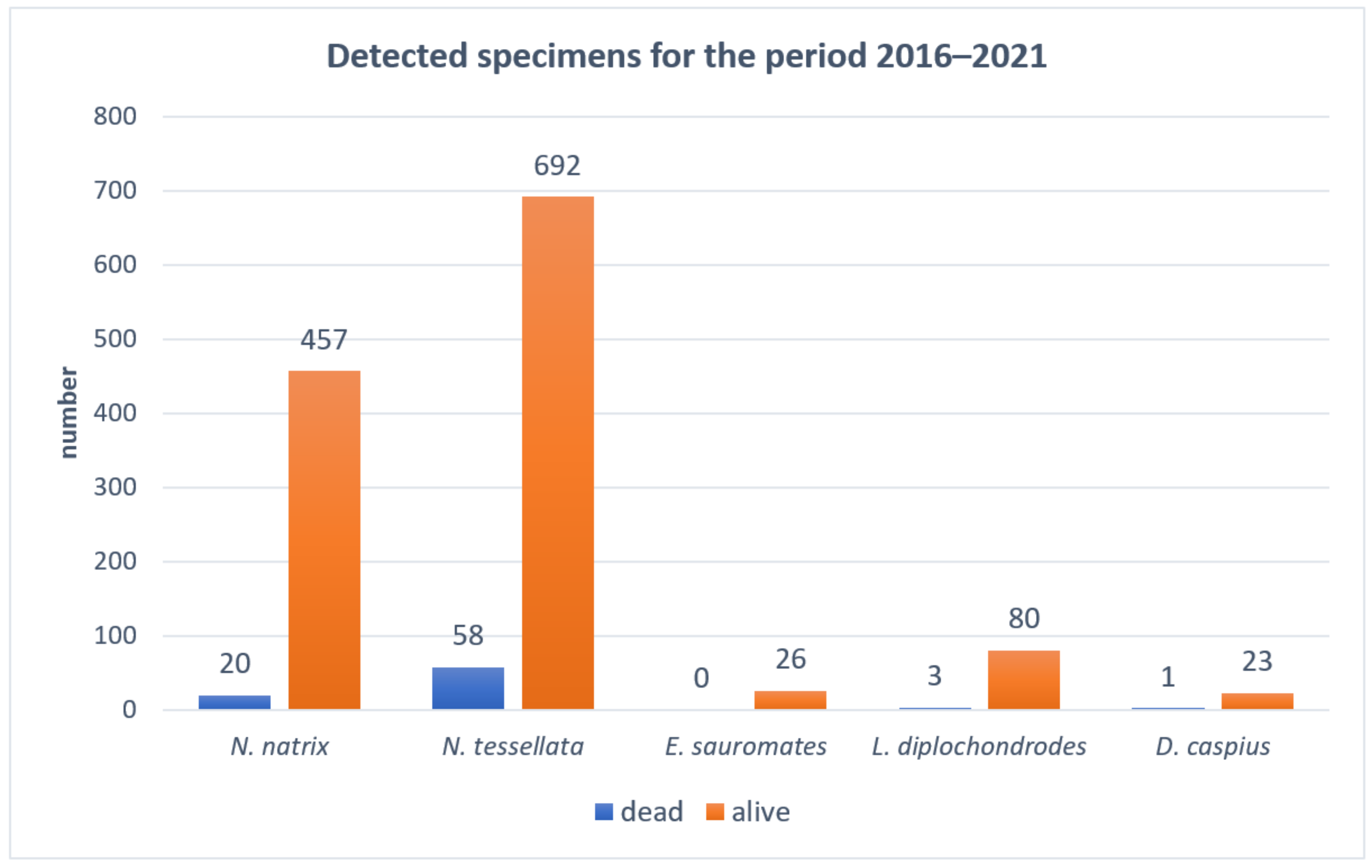



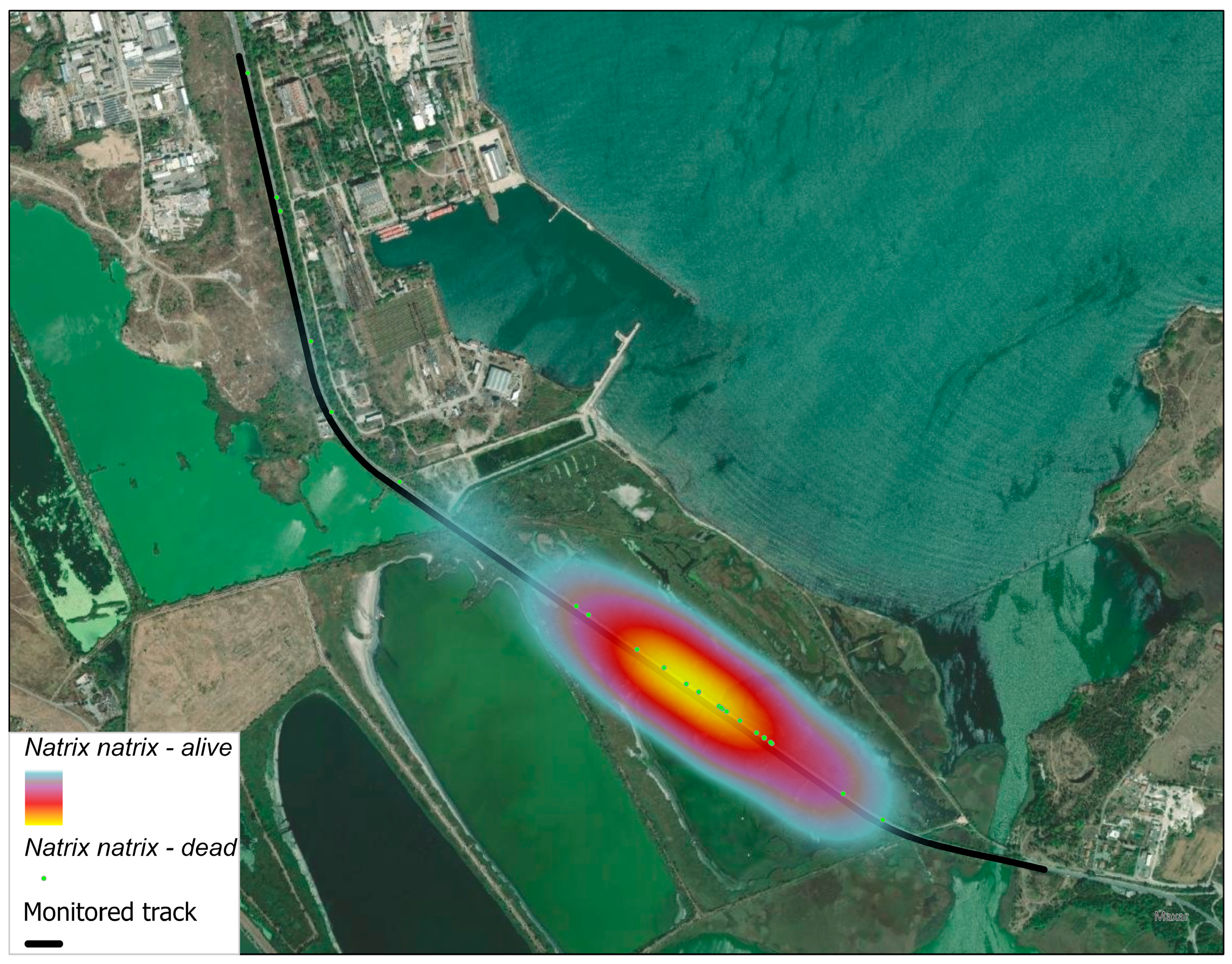
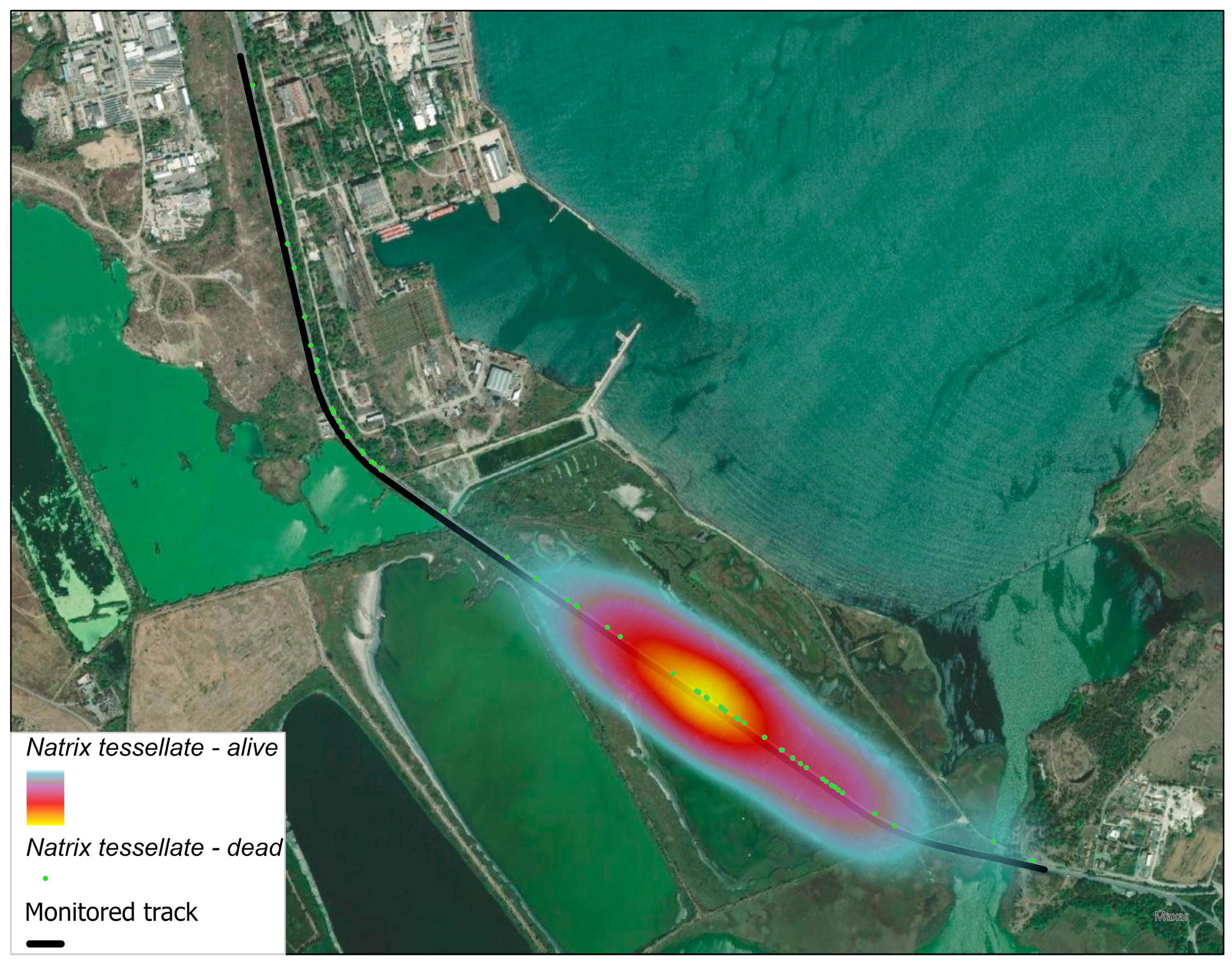
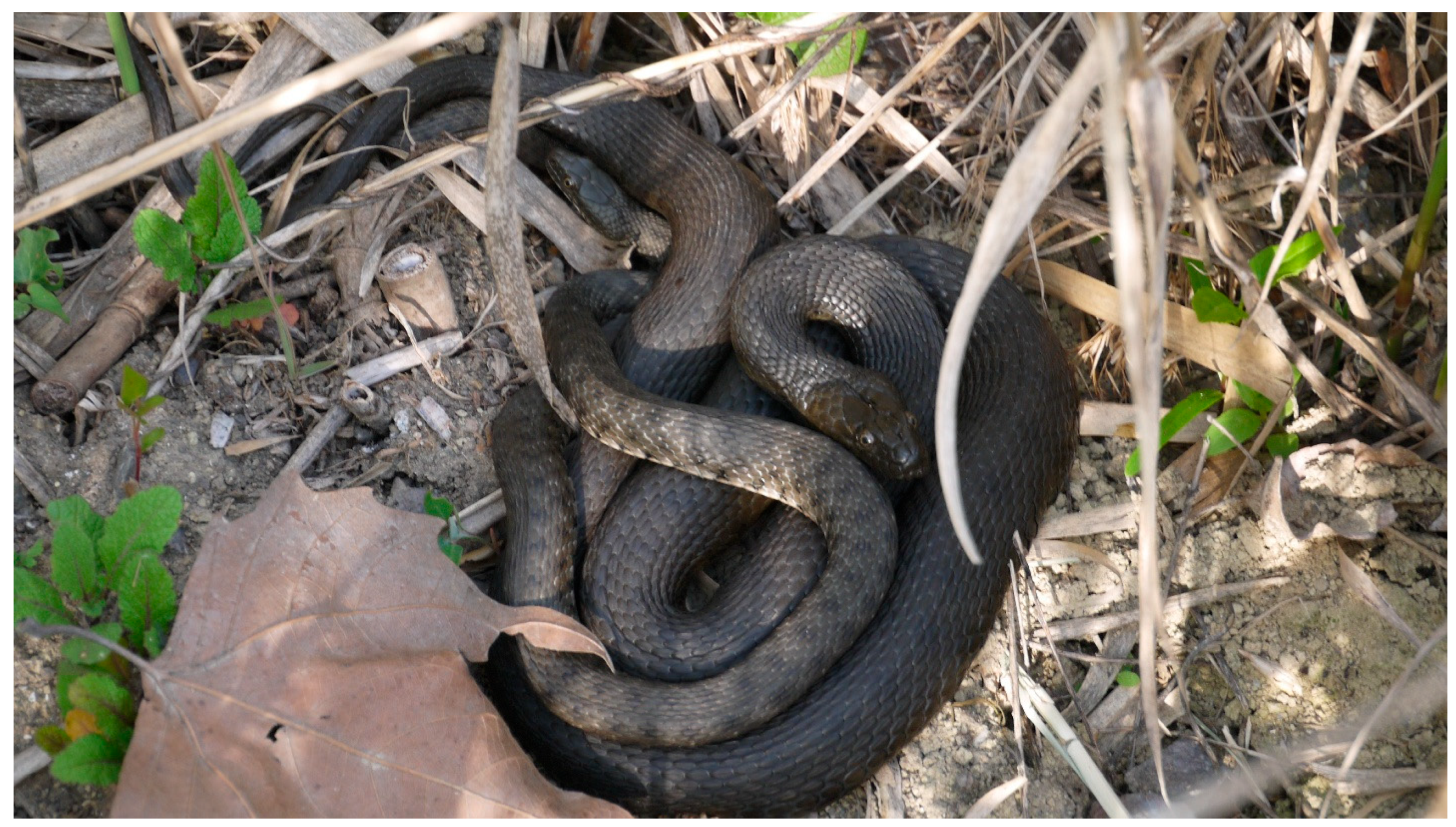
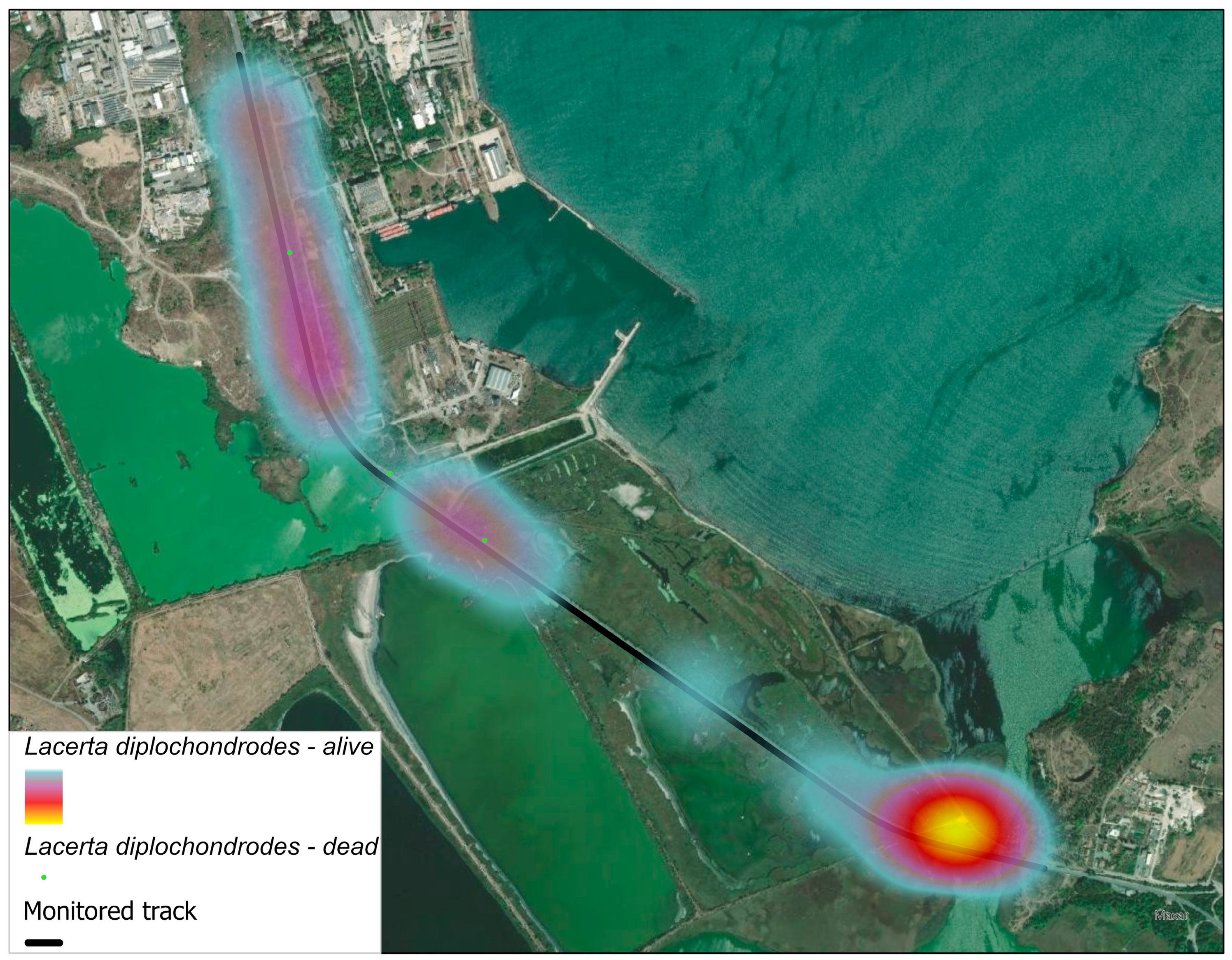


| Year | March | April | May | June | July | August | September | October | Total | ||||||||
|---|---|---|---|---|---|---|---|---|---|---|---|---|---|---|---|---|---|
| Dead | Alive | Dead | Alive | Dead | Alive | Dead | Alive | Dead | Alive | Dead | Alive | Dead | Alive | Dead | Alive | ||
| 2016 | 1 | 2 | 3 | ||||||||||||||
| 2017 | 1 | 2 | 3 | ||||||||||||||
| 2018 | 2 | 3 | 1 | 6 | |||||||||||||
| 2019 | 1 | 2 | 3 | ||||||||||||||
| 2020 | 2 | 5 | 7 | ||||||||||||||
| 2021 | 2 | 3 | 5 | ||||||||||||||
| Total | 0 | 5 | 10 | 12 | 0 | 0 | 0 | 0 | 27 | ||||||||
| Year | March | April | May | June | July | August | September | October | Total | ||||||||
|---|---|---|---|---|---|---|---|---|---|---|---|---|---|---|---|---|---|
| Dead | Alive | Dead | Alive | Dead | Alive | Dead | Alive | Dead | Alive | Dead | Alive | Dead | Alive | Dead | Alive | ||
| 2016 | 2 | 1 | 3 | ||||||||||||||
| 2017 | 1 | 3 | 4 | ||||||||||||||
| 2018 | 4 | 2 | 4 | 2 | 12 | ||||||||||||
| 2019 | 1 | 1 | |||||||||||||||
| 2020 | 3 | 2 | 1 | 6 | |||||||||||||
| 2021 | 1 | 1 | |||||||||||||||
| Total | 0 | 5 | 10 | 7 | 1 | 3 | 1 | 0 | 27 | ||||||||
| Year | March | April | May | June | July | August | September | October | Total | ||||||||
|---|---|---|---|---|---|---|---|---|---|---|---|---|---|---|---|---|---|
| Dead | Alive | Dead | Alive | Dead | Alive | Dead | Alive | Dead | Alive | Dead | Alive | Dead | Alive | Dead | Alive | ||
| 2016 | 3 | 6 | 1 | 1 | 11 | ||||||||||||
| 2017 | 6 | 1 | 54 | 15 | 8 | 26 | 5 | 115 | |||||||||
| 2018 | 18 | 2 | 90 | 1 | 13 | 3 | 127 | ||||||||||
| 2019 | 9 | 2 | 39 | 53 | 14 | 117 | |||||||||||
| 2020 | 4 | 29 | 6 | 35 | 1 | 5 | 80 | ||||||||||
| 2021 | 18 | 9 | 27 | ||||||||||||||
| Total | 15 | 77 | 189 | 132 | 31 | 26 | 1 | 6 | 477 | ||||||||
| Year | March | April | May | June | July | August | September | October | Total | ||||||||
|---|---|---|---|---|---|---|---|---|---|---|---|---|---|---|---|---|---|
| Dead | Alive | Dead | Alive | Dead | Alive | Dead | Alive | Dead | Alive | Dead | Alive | Dead | Alive | Dead | Alive | ||
| 2016 | 2 | 1 | 3 | 2 | 8 | ||||||||||||
| 2017 | 10 | 16 | 18 | 1 | 3 | 38 | 3 | 89 | |||||||||
| 2018 | 21 | 7 | 151 | 12 | 58 | 3 | 252 | ||||||||||
| 2019 | 1 | 2 | 59 | 3 | 71 | 2 | 39 | 177 | |||||||||
| 2020 | 11 | 55 | 12 | 81 | 1 | 12 | 172 | ||||||||||
| 2021 | 30 | 2 | 20 | 52 | |||||||||||||
| Total | 11 | 112 | 262 | 258 | 61 | 38 | 5 | 3 | 750 | ||||||||
| Year | March | April | May | June | July | August | September | October | Total | ||||||||
|---|---|---|---|---|---|---|---|---|---|---|---|---|---|---|---|---|---|
| Dead | Alive | Dead | Alive | Dead | Alive | Dead | Alive | Dead | Alive | Dead | Alive | Dead | Alive | Dead | Alive | ||
| 2016 | 1 | 1 | |||||||||||||||
| 2017 | 2 | 1 | 3 | 2 | 8 | ||||||||||||
| 2018 | 4 | 10 | 1 | 4 | 1 | 2 | 22 | ||||||||||
| 2019 | 3 | 7 | 11 | 1 | 22 | ||||||||||||
| 2020 | 3 | 1 | 12 | 5 | 21 | ||||||||||||
| 2021 | 4 | 5 | 9 | ||||||||||||||
| Total | 5 | 15 | 22 | 32 | 7 | 0 | 2 | 0 | 83 | ||||||||
Disclaimer/Publisher’s Note: The statements, opinions and data contained in all publications are solely those of the individual author(s) and contributor(s) and not of MDPI and/or the editor(s). MDPI and/or the editor(s) disclaim responsibility for any injury to people or property resulting from any ideas, methods, instructions or products referred to in the content. |
© 2025 by the authors. Licensee MDPI, Basel, Switzerland. This article is an open access article distributed under the terms and conditions of the Creative Commons Attribution (CC BY) license (https://creativecommons.org/licenses/by/4.0/).
Share and Cite
Natchev, N.; Marinova, P.; Telenchev, I.; Nedyalkov, N.; Ali, A.; Koynova, T. Living Safely: Low Road Mortality in Squamates near Burgas, Bulgaria. Ecologies 2025, 6, 68. https://doi.org/10.3390/ecologies6040068
Natchev N, Marinova P, Telenchev I, Nedyalkov N, Ali A, Koynova T. Living Safely: Low Road Mortality in Squamates near Burgas, Bulgaria. Ecologies. 2025; 6(4):68. https://doi.org/10.3390/ecologies6040068
Chicago/Turabian StyleNatchev, Nikolay, Pavlina Marinova, Ivan Telenchev, Nikolay Nedyalkov, Aysun Ali, and Teodora Koynova. 2025. "Living Safely: Low Road Mortality in Squamates near Burgas, Bulgaria" Ecologies 6, no. 4: 68. https://doi.org/10.3390/ecologies6040068
APA StyleNatchev, N., Marinova, P., Telenchev, I., Nedyalkov, N., Ali, A., & Koynova, T. (2025). Living Safely: Low Road Mortality in Squamates near Burgas, Bulgaria. Ecologies, 6(4), 68. https://doi.org/10.3390/ecologies6040068






